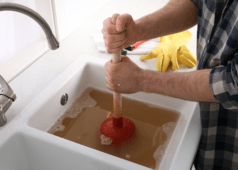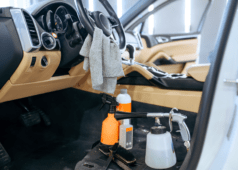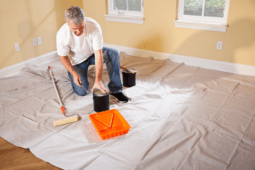Shop Skills: How to Clean Your Saw Blades

Maintaining your shop tools starts with keeping those blades sharp and well lubricated. Here’s a quick overview on how to tune up your cutting edges. A few times a year, I take a break from working in my shop and spend a few hours working on it. After oiling up the various moving parts and sucking a huge amount of sawdust from the corners I turn my attention to the most important surfaces in my shop – my cutting edges. Saw blades are under-appreciated and generally neglected until they’re smoking through that huge piece of hardwood or chipping out an expensive plywood panel. After reading a few forum posts recently, I picked up a clean non-toxic blade and bit cleaner and lubricant that really brought my blades back from their sap-laden state.
- CMT Formula 2050 Blade and Bit Cleaner $14.50
- Bostik Bladecote (formerly Dricote) $18.50
- Bostik Glidecote (formerly Topcote) $18.50
![credit: David [manmadediy.com] Product Shots](https://s3.amazonaws.com/manmadediy-uploads-production/photos/25822/untitled%20shoot-006-2_large.jpg?1433152730)
The non-toxic cleaner is biodegradable and there are no fumes to suffer through so using it is much better on the lungs compared to other products on the market. The lubricant adds a protective layer that keeps the blade sharp longer and helps it to cut through hard wood a bit easier. Here are the steps to get those blades from grimy to gleaming.
1. First, keep in mind that carbide edges are brittle and break off easily, they’re also very sharp so handle very carefully. Gloves should be worn to keep your hands protected.![credit: David [manmadediy.com] Carbide Tips](https://s3.amazonaws.com/manmadediy-uploads-production/photos/25823/untitled%20shoot-001-2_large.jpg?1433152835)
2. Remove all blades and carefully check blade edges for sharpness. Check for any chips or broken teeth. While a few small nicks won’t ruin a cut, anything more than minor wear could require a fresh sharpening.
![credit: David [manmadediy.com] Spray off Blades](https://s3.amazonaws.com/manmadediy-uploads-production/photos/25824/untitled%20shoot-015-2_large.jpg?1433152933)
3. In a small plastic bin, spray down both sides of the blade and let soak for a few minutes. After a brief soak, scrub the blade edges where pitch is build up with a nylon brush. Don’t use wire which can damage the edges.
![credit: David [manmadediy.com] Scrubbing Blades](https://s3.amazonaws.com/manmadediy-uploads-production/photos/25825/untitled%20shoot-007_large.jpg?1433153009)
4. Once the blades are well scrubbed, I like to let them soak in warm water to free up any left-over residue. Directions on the blade cleaner say that it doesn’t need to be rinsed off, but since I’m adding a layer of protective lubricant onto the blade I wipe them clean to prepare for the final spray-down.
![credit: David [manmadediy.com] Rinsing off Blades](https://s3.amazonaws.com/manmadediy-uploads-production/photos/25826/untitled%20shoot-025_large.jpg?1433153087)
5. With the blades fully rinsed and dry, spray on the lubricant and re-install into your tools for a few more months of clean cutting.![credit: David [manmadediy.com] Lubricated Blades](https://s3.amazonaws.com/manmadediy-uploads-production/photos/25827/untitled%20shoot-039_large.jpg?1433153149)
I also picked up Bostik’s Glide Coat for my tool surfaces and what a difference it makes. After a few solid coats, materials slide over the table like they’re on ball bearings. To upgrade your wood-cutting experience, it’s a simple process for great results.
![credit: David [manmadediy.com] Cleaned Blades](https://s3.amazonaws.com/manmadediy-uploads-production/photos/25828/untitled%20shoot-035_large.jpg?1433153217)
Note: This isn’t a sponsored post, I was just impressed with the process and thought you might be as well. Now get out there and polish up your shop so you can go back to making sawdust.









